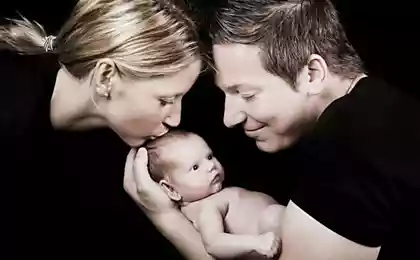844
The child sleeps poorly 6 major mistakes that parents
"How to put baby to sleep" - one of the biggest challenges facing parents. Even parents of "good sleepers" children are often faced with the dilemma of accidentally fallen asleep baby - leave to sleep "in the night" and wake up later and laid again. Anyway, according to statistics 40 per cent of children suffer from some kind of sleep problems.
Experts have identified the six most common mistakes made by parents when it comes to placing a child to sleep. The good news here is that these errors can be corrected without much effort. Baby sleep experts and parents with experience confirms that even simple changes in the child mode and the environment can make a big difference in preventing or avoiding the most common sleep problems.
And once you succeed, and your child will start in time to go to bed and the night will wake up happy and well rested will not only baby, but also to all your family.

1. Error: laying the kids to bed too late
Modern children sleep a lot less than their parents were asleep at the time. "In infancy and early adolescence children get less sleep than children in the mid-70s and 80s," - says Mark Vaysblutt, pediatrician and author of "Healthy Sleep Habits: happy child." One recent study has shown that 2-year-old kids today are sleeping 40 minutes less than 2 yrs few generations ago. The result of the late laying manifested in the "war" before falling asleep, difficulty with day bed and night awakenings.
It is possible that your baby is not well-established sleep, or you come back late from work and want to devote more time to the baby. "Children who are overworked, sleep a lot later," - says an expert on sleep Jill Spivak. When a child is overtired, it is more difficult to fall asleep, and falling asleep, he gets up earlier than if he had been put to bed at the right time. »
In the preschool period and during elementary school, with countless sports training, or after school, the child is very difficult to find time for an afternoon nap and go early in the evening. "A lot of children very much needed employment," - says Jodi Mindell, deputy director of the Sleep Center at the Children's Hospital of Philadelphia
. Think about it: at that time, when all your family members back home, eat dinner, do household chores and so on, timely going to bed can be a low priority and unlikely. And many in this situation tend to give up an afternoon nap, hoping thereby to avoid night battles before going or thinking that tired and exhausted and so the child will fall asleep without third-party intervention. "But it is - madness, a big mistake", - says Mindell, because when children are too tired, they are unable to sleep
. What to do: Enter the clear (overdue after 10 months.) Sleep mode (including an afternoon nap when the baby sleeps during the day)
. Help your child to adhere strictly to the regime. And do not wait until your child starts to rub his eyes, yawn or capricious - it will be too late. Put him to sleep before then. Even 15-20 minutes of extra sleep can make a difference. Since all children are different, Spivack says that during the night and newborn babies usually need 11 o'clock sleep, pre-school children, from the moment they cease to sleep during the day - 12 hours, and older children - 10-11 hours
<. br> 2. Error: dream in motion
Many parents sigh with relief when their baby falls asleep while rocking in the cradle or "compacting" in the back seat of the car. But often these wonderful moments occur when you least expect it. Some moms and dads fall into the "compacting" the use of the trap in order to put their small children to sleep during the day, or even at night. "If a child always sleeps on the move - in a sling or a car - it probably does not get deep reducing sleep due to excitement inherent in the movement sleep," - says the well-known American expert on sleep, a pediatrician, Dr. Vaysblutt. He compares the child's dream in motion with superficial sleep, sleeping adults, such as flying in an airplane.
What to do: Use motion only to soothe, but not put to sleep
. Before you will be resent from the words that the constant motion sickness is not desirable for the baby, listen to the following advice Vaysblutta "Motion sickness should be used only in order to calm the baby. But as soon as your child is asleep, you must stop the rocking "" The child must be the best - quality sleep, "- says Vayssblutt. Tip: If you take the baby with them on a long car ride, and your baby doze off, sit back and enjoy the moment of silence !!!
6 major mistakes that parents
3. Error: distracting details
Many parents when a baby is placed, put in his crib toy, conventional or music, your mobile phone. But toys, with their sound and lights, too distracting the child from thinking about the dream. "She did not fall asleep with a mobile phone. There were a lot of bright colors, it retained its activity, rather than to remind that already
night. " Hyperactivity during sleep may not only be a newborn. If you have older children in bed a lot of toys or other distractions (glowing wallpaper or stars on the ceiling), they may not get sleep they need.
What to do: during sleep the child shall not be included light, nightlight
. To maximize infants and toddlers sleep - those who are too young to have time to develop night terrors - accustom to sleep in nearly pitch black rooms. Use a fan or a white noise machine to muffle any sounds from the street or from the next room.
Older children can be a night light with soft light to calm and overcome any fears, but no entertainment during sleep should not be. Think long and hard before allowing to place in your child's bedroom TV or computer. Even children who fall asleep with your favorite DVD, lose about 30 minutes of precious sleep - and it is a loss that can spoil their mood and behavior for the whole day, and it is easier to remove the electronics from the bedroom than every evening encounter difficulties placing overwrought child to sleep <. br>
4. Error: violation of ritual bedtime
As a child, you probably could have guessed that the rituals that consist of a bath, books, and a lullaby is not so necessary. But the formation of the conventions in behavior, by which the child will understand that it is time to sleep and in the future he is going to bed at a certain time, must take place at an early age. Selected ritual will help a child at any age go to bed at a specified time.
Parents of adult children who observe the ritual of going to bed, can start to break it, because they mistakenly believe that their child has grown up, or because they are too tired from the constant observance of ritual. Even parents will benefit from the availability of ritual to plan your evening in a certain way, and these plans will not be disrupted many hours laying the baby to bed.
What to do: to observe the calming ritual
. Whatever your child's age should be a known sequence of steps or "sleep stimulants" that help dityu insist on a dream. For the baby it can be as simple as getting dressed in pajamas and hugging mom or motion sickness; with older children - a bath, reading a book, a lullaby or a prayer
. You can come up with your own ritual.
5. Error: inconsistent
A couple of times a week, when he really whiny, you lie down with your child in his crib until he falls asleep. Or perhaps you stacked your child in his room, but sometimes let him come into your bed in the middle of the night.
The problem is not even the method of laying there sleeping, and lack of consistency in its application. Many parents do not mind when a child sleeps with them, but all too often it ends with "family bed", which they had originally planned not.
"My parents allow the child to go to bed, but did not want him to stay in bed with them at night," says Owens. This scenario only reinforces the inconsistency.
"It is, in fact, teaches the child that he will eventually get what he wants," - explains Owens
. What to do: enter "code" of the rules about where and how to sleep child
. Though it is better to decide for themselves in advance whether you want a family bed, but it should never be too late to set the rules. If you want to wean your baby to bed with you or the child began to wake up at night and come to you, you need to gently but firmly grasp give the kid, it's time to sleep in his bed.
Of course there are exceptions. If your child is sick or afraid of sudden onset of a thunderstorm, do not hesitate to comfort him, staying with him in his bed or sleeping on an inflatable mattress in his room. But as soon as the illness or the storm subsides, return to the regular mode.
The child, who had a comfortable snuggling up to her mother on one side and to the Pope, on the other, may be indignant. In this case, Dr. Mindell offers drag out the process for a few days -perhaps, standing in the doorway until your child does not fall asleep for a few nights before the baby finally moved into his crib.
6 major mistakes that parents
6. Error: too early "resettlement" in a large crib
Your baby is 2 years old, and you hurry to buy him a new wonderful bed, which saw in the store. But as soon as you turn off the light and leave the baby in his new bed, he starts to get up, run away to you or starts to sleep less.
Why? Until about 3 years of age, many children are not willing to leave his previous crib. "Their cognitive skills and self-control is not enough to remain within the imaginary boundaries of the bed," - says Mindell
. What to do: wait until your child is ripe for a big bed
. When the child reaches the age of 3 years, you can think about how to move it into a big bed. However, if your child has trouble sleeping in a new bed, you can always give it more time. This is a temporary return to diapers after several unsuccessful attempts to toilet training.
"If it fails, there is nothing wrong with the return to the previous version," - says Mindell. Your child will eventually still be able to sleep comfortably in a large crib and may even ask for it. "There is not one child going to kindergarten, which is still sleeping in the cradle" - reminds Mindell.
Experts have identified the six most common mistakes made by parents when it comes to placing a child to sleep. The good news here is that these errors can be corrected without much effort. Baby sleep experts and parents with experience confirms that even simple changes in the child mode and the environment can make a big difference in preventing or avoiding the most common sleep problems.
And once you succeed, and your child will start in time to go to bed and the night will wake up happy and well rested will not only baby, but also to all your family.

1. Error: laying the kids to bed too late
Modern children sleep a lot less than their parents were asleep at the time. "In infancy and early adolescence children get less sleep than children in the mid-70s and 80s," - says Mark Vaysblutt, pediatrician and author of "Healthy Sleep Habits: happy child." One recent study has shown that 2-year-old kids today are sleeping 40 minutes less than 2 yrs few generations ago. The result of the late laying manifested in the "war" before falling asleep, difficulty with day bed and night awakenings.
It is possible that your baby is not well-established sleep, or you come back late from work and want to devote more time to the baby. "Children who are overworked, sleep a lot later," - says an expert on sleep Jill Spivak. When a child is overtired, it is more difficult to fall asleep, and falling asleep, he gets up earlier than if he had been put to bed at the right time. »
In the preschool period and during elementary school, with countless sports training, or after school, the child is very difficult to find time for an afternoon nap and go early in the evening. "A lot of children very much needed employment," - says Jodi Mindell, deputy director of the Sleep Center at the Children's Hospital of Philadelphia
. Think about it: at that time, when all your family members back home, eat dinner, do household chores and so on, timely going to bed can be a low priority and unlikely. And many in this situation tend to give up an afternoon nap, hoping thereby to avoid night battles before going or thinking that tired and exhausted and so the child will fall asleep without third-party intervention. "But it is - madness, a big mistake", - says Mindell, because when children are too tired, they are unable to sleep
. What to do: Enter the clear (overdue after 10 months.) Sleep mode (including an afternoon nap when the baby sleeps during the day)
. Help your child to adhere strictly to the regime. And do not wait until your child starts to rub his eyes, yawn or capricious - it will be too late. Put him to sleep before then. Even 15-20 minutes of extra sleep can make a difference. Since all children are different, Spivack says that during the night and newborn babies usually need 11 o'clock sleep, pre-school children, from the moment they cease to sleep during the day - 12 hours, and older children - 10-11 hours
<. br> 2. Error: dream in motion
Many parents sigh with relief when their baby falls asleep while rocking in the cradle or "compacting" in the back seat of the car. But often these wonderful moments occur when you least expect it. Some moms and dads fall into the "compacting" the use of the trap in order to put their small children to sleep during the day, or even at night. "If a child always sleeps on the move - in a sling or a car - it probably does not get deep reducing sleep due to excitement inherent in the movement sleep," - says the well-known American expert on sleep, a pediatrician, Dr. Vaysblutt. He compares the child's dream in motion with superficial sleep, sleeping adults, such as flying in an airplane.
What to do: Use motion only to soothe, but not put to sleep
. Before you will be resent from the words that the constant motion sickness is not desirable for the baby, listen to the following advice Vaysblutta "Motion sickness should be used only in order to calm the baby. But as soon as your child is asleep, you must stop the rocking "" The child must be the best - quality sleep, "- says Vayssblutt. Tip: If you take the baby with them on a long car ride, and your baby doze off, sit back and enjoy the moment of silence !!!
6 major mistakes that parents
3. Error: distracting details
Many parents when a baby is placed, put in his crib toy, conventional or music, your mobile phone. But toys, with their sound and lights, too distracting the child from thinking about the dream. "She did not fall asleep with a mobile phone. There were a lot of bright colors, it retained its activity, rather than to remind that already
night. " Hyperactivity during sleep may not only be a newborn. If you have older children in bed a lot of toys or other distractions (glowing wallpaper or stars on the ceiling), they may not get sleep they need.
What to do: during sleep the child shall not be included light, nightlight
. To maximize infants and toddlers sleep - those who are too young to have time to develop night terrors - accustom to sleep in nearly pitch black rooms. Use a fan or a white noise machine to muffle any sounds from the street or from the next room.
Older children can be a night light with soft light to calm and overcome any fears, but no entertainment during sleep should not be. Think long and hard before allowing to place in your child's bedroom TV or computer. Even children who fall asleep with your favorite DVD, lose about 30 minutes of precious sleep - and it is a loss that can spoil their mood and behavior for the whole day, and it is easier to remove the electronics from the bedroom than every evening encounter difficulties placing overwrought child to sleep <. br>
4. Error: violation of ritual bedtime
As a child, you probably could have guessed that the rituals that consist of a bath, books, and a lullaby is not so necessary. But the formation of the conventions in behavior, by which the child will understand that it is time to sleep and in the future he is going to bed at a certain time, must take place at an early age. Selected ritual will help a child at any age go to bed at a specified time.
Parents of adult children who observe the ritual of going to bed, can start to break it, because they mistakenly believe that their child has grown up, or because they are too tired from the constant observance of ritual. Even parents will benefit from the availability of ritual to plan your evening in a certain way, and these plans will not be disrupted many hours laying the baby to bed.
What to do: to observe the calming ritual
. Whatever your child's age should be a known sequence of steps or "sleep stimulants" that help dityu insist on a dream. For the baby it can be as simple as getting dressed in pajamas and hugging mom or motion sickness; with older children - a bath, reading a book, a lullaby or a prayer
. You can come up with your own ritual.
5. Error: inconsistent
A couple of times a week, when he really whiny, you lie down with your child in his crib until he falls asleep. Or perhaps you stacked your child in his room, but sometimes let him come into your bed in the middle of the night.
The problem is not even the method of laying there sleeping, and lack of consistency in its application. Many parents do not mind when a child sleeps with them, but all too often it ends with "family bed", which they had originally planned not.
"My parents allow the child to go to bed, but did not want him to stay in bed with them at night," says Owens. This scenario only reinforces the inconsistency.
"It is, in fact, teaches the child that he will eventually get what he wants," - explains Owens
. What to do: enter "code" of the rules about where and how to sleep child
. Though it is better to decide for themselves in advance whether you want a family bed, but it should never be too late to set the rules. If you want to wean your baby to bed with you or the child began to wake up at night and come to you, you need to gently but firmly grasp give the kid, it's time to sleep in his bed.
Of course there are exceptions. If your child is sick or afraid of sudden onset of a thunderstorm, do not hesitate to comfort him, staying with him in his bed or sleeping on an inflatable mattress in his room. But as soon as the illness or the storm subsides, return to the regular mode.
The child, who had a comfortable snuggling up to her mother on one side and to the Pope, on the other, may be indignant. In this case, Dr. Mindell offers drag out the process for a few days -perhaps, standing in the doorway until your child does not fall asleep for a few nights before the baby finally moved into his crib.
6 major mistakes that parents
6. Error: too early "resettlement" in a large crib
Your baby is 2 years old, and you hurry to buy him a new wonderful bed, which saw in the store. But as soon as you turn off the light and leave the baby in his new bed, he starts to get up, run away to you or starts to sleep less.
Why? Until about 3 years of age, many children are not willing to leave his previous crib. "Their cognitive skills and self-control is not enough to remain within the imaginary boundaries of the bed," - says Mindell
. What to do: wait until your child is ripe for a big bed
. When the child reaches the age of 3 years, you can think about how to move it into a big bed. However, if your child has trouble sleeping in a new bed, you can always give it more time. This is a temporary return to diapers after several unsuccessful attempts to toilet training.
"If it fails, there is nothing wrong with the return to the previous version," - says Mindell. Your child will eventually still be able to sleep comfortably in a large crib and may even ask for it. "There is not one child going to kindergarten, which is still sleeping in the cradle" - reminds Mindell.
You should know this! Baker's yeast - is made according to GOST
A good way to understand the child's feelings when a young family























